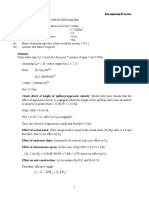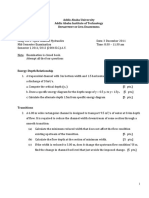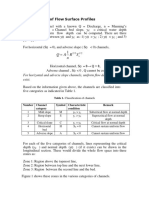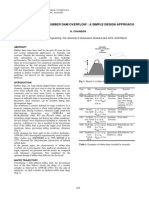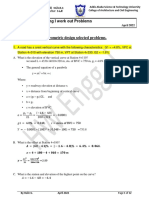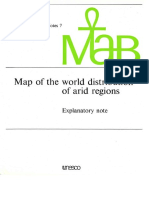Reservoir Flood Routing (Hydrograph Routing) 12 PDF
Reservoir Flood Routing (Hydrograph Routing) 12 PDF
Uploaded by
gladCopyright:
Available Formats
Reservoir Flood Routing (Hydrograph Routing) 12 PDF
Reservoir Flood Routing (Hydrograph Routing) 12 PDF
Uploaded by
gladOriginal Title
Copyright
Available Formats
Share this document
Did you find this document useful?
Is this content inappropriate?
Copyright:
Available Formats
Reservoir Flood Routing (Hydrograph Routing) 12 PDF
Reservoir Flood Routing (Hydrograph Routing) 12 PDF
Uploaded by
gladCopyright:
Available Formats
cmutsvangwa: Hydrology: Dept. Civil and Water Eng.
, NUST 5/3/2007
Chapter 12
RESERVOIR FLOOD ROUTING (HYDROGRAPH ROUTING)
Introduction
The design of dams involves the sizing of appurtenances like the spillway, outlets
and determining the storage capacity. It is a complex phenomenon and if not
professionally done, can lead to catastrophic dam failures. Of late in Zimbabwe,
dam failures are becoming common and mainly due to poor designs and
workmanship. In most cases it will be failure of the spillway to cope with the peak
discharge which may occur during the design period based on the recurrence
interval. With regard to this, the hydrology of proposed dam sites needs to be
studied. This data is necessary to carryout flood routing which will enable sizing
the spillway and other dam appurtenances.
Flood routing
A process that shows how the inflow hydrograph during peak discharge (flood
wave) can be reduced in magnitude and lengthened in time (attenuated) by use
of storage in the reach between two points. It predicts the temporal and spatial
variation of a flood wave as it traverses a river reach or reservoir. It can be used
to predict the outflow hydrograph from a catchment area. The resultant outflow
hydrograph is then used to size the spillway.
Categories of flood routing
• Hydrologic
• Hydraulic
Hydrologic
It employs the equation of continuity with either an analytical or an assumed
relation between storage and discharge within the system. Hydrologic routing is
useful for flood prediction and evaluation of flood control measures.
Hydraulic routing
It uses the equation of continuity and the equation of motion (momentum). It
utilizes the partial differential equation for unsteady flow in open channels. Its
advantage is that it adequately describes the dynamics of flow than the
hydrologic technique.
Types of hydrologic routing
• hydrologic river routing (channel)
• hydrologic reservoir routing
Chapter 12: Reservoir and stream flood routing
cmutsvangwa: Hydrology: Dept. Civil and Water Eng., NUST 5/3/2007
Hydrologic reservoir routing
A flood wave passing through a storage is both delayed and attenuated as it
enters and spreads over a pool surface (Fig. 1). Water stored in the reservoir is
gradually released as pipe flow through outlet works called spillways or through
emergency spillway in extreme floods.
Translation
Attenuation
Q
S=I-O
Outflow
Outflow
Fig. 1: Inflow and outflow hydrograph
The outflow hydrograph is governed by the inflow hydrograph, weir and storage
characteristics. The procedure is summarized in the flow chart in Fig. 2.
Storage characteristics
This is the relationship between storage and height of the dam basin. A plot of
height against storage gives a capacity curve.
Weir characteristics
The shape of the weir (cill) of the spillway affects the overflow efficiency. For
small dams the spillway is normally stepped or sloped to the downstream with a
vertical face upstream. The efficiency of a weir is measured by the coefficient of
discharge. In practice the discharge coefficient varies between 1.7-1.84 (Baban,
1995). The discharge over a an un-gated spillway weir section can be described
from energy, momentum and continuity consideration by the form:
Q = C d LH x (1)
Where: Q =outflow rate
H =height of water surface above the crest of spillway, m
Cd = coefficient of discharge of the weir section (theoretically 3
or ≅ 1.8)
L = length of spillway, m
Chapter 12: Reservoir and stream flood routing
cmutsvangwa: Hydrology: Dept. Civil and Water Eng., NUST 5/3/2007
3
x =exponent, theoretically
2
Input parameters
Inflow hydrograph Output Outflow hydrograph
Storage characteristics, S = f(H)
Weir characteristics
Inflow, I Peak Discharge, Qmax
Spillway level
Storage, S Outflow, Q
H
Spillway design
Weir
Fig. 2. Schematic illustration of flood routing
Inflow hydrograph
The problem of flood routing is solved by applying the hydrologic equation:
Inflow =Outflow + incremental storage at any instant
I = Q + ∆S (2)
ds
⇒ I =Q+ (3)
dt
Where: I =inflow to the reach
Q =outflow rate
ds
=rate of change in reach storage with respect to time
dt
S is often defined as the surcharge storage or the storage above the spillway
crest i.e. outflow is zero when S=0.
Expressing the storage equation in finite difference form:
Chapter 12: Reservoir and stream flood routing
cmutsvangwa: Hydrology: Dept. Civil and Water Eng., NUST 5/3/2007
(I t + I t + ∆t ) (Qt + Qt + ∆t )
∆t − ∆t = S t + ∆t − S t (4)
2 2
Where: It, Qt =inflow and outflow rates at time t
I t + ∆t , Qt + ∆t =inflow and outflow rates at time at t+∆t
t =routing period
The routing period, t selected should be sufficiently short such that the
hydrograph during the interval t to t + ∆t can be assumed as a straight line, i.e.
I t + I t + ∆t
I mean = (5)
2
Inflow discharge method
The inflow discharge method can be applied to solve the equation 4. The
equation is rearranged:
(I t + I t + ∆t ) Qt Q
∆t + S t − ∆t = S t + ∆t = S t + ∆t + t + ∆t ∆t (6)
2 2 2
(I t + I t + ∆t ) S t Qt S t + ∆t Qt + ∆t
+ − = + (7)
2 ∆t 2 ∆t 2
The above equation is difficult to solve since both the S and Q can be complex
functions of H, the head over the weir, and therefore a semi-graphical method is
used. The equation is solved successively through time for a known inflow
hydrograph if the storage volume can be related to outflow.
The storage-elevation relationship is computed from the basin survey and the
stage-discharge relationship from the weir equation (Figs. 3 and 4).
If annual river discharges are available, the inflow hydrograph can be derived but
on many occasions this data is not available and the simplest method of deriving
the inflow hydrograph is by applying the Triangular Model Hydrograph and the
Rational Formula. The procedure involves computing:
• Maximum probable flood, MPF or peak discharge (Qmax).
• Rainfall intensity, I
• Storm duration, Tp
• Using the Standard ratios and discharge as given by the USBR (Table 1.)
the inflow hydrograph is projected. The time and discharges ratios are
multiplied by the storm duration, Tp and peak discharge, Qp respectively.
Chapter 12: Reservoir and stream flood routing
cmutsvangwa: Hydrology: Dept. Civil and Water Eng., NUST 5/3/2007
storage, S
Fig. 3
Fig. 4
Example
(i) Derive the inflow and outflow hydrographs using data from previous
examples for a reservoir with a 36m long spillway and vertical sides
and plan area of 5000m2. The storage is given as S = 50 000H.
(ii) Estimate the peak outflow discharge
Solution
Calculate the maximum probable flood (previous example).
(i) MPF=65m3/s)
(ii) Rainfall intensity from equation previous equation
5
Chapter 12: Reservoir and stream flood routing
cmutsvangwa: Hydrology: Dept. Civil and Water Eng., NUST 5/3/2007
65 × 6.87
I= =45mm/hr
10
Table 1 USBR Standard ratios for deriving a hydrograph
Time Discharge Time Discharge Time Discharge
ratio ratio ratio ratio ratio ratio
T/Tp Q/Qp T/Tp Q/Qp T/Tp Q/Qp
0 0 1.0 1.0 2.4 0.18
0.1 0.015 1.1 0.98 2.6 0.13
0.2 0.075 1.2 0.92 2.8 0.098
0.3 0.15 1.3 0.84 3 0.075
0.4 0.28 1.4 0.75 3.5 0.036
0.5 0.43 1.5 0.66 4 0.018
0.6 0.6 1.6 0.56 4.5 0.009
0.7 0.77 1.8 0.42 5 0.004
0.8 0.89 2 0.32
0.9 0.97 2.2 0.24
(iii) Storm duration:
2050 log[NR ] − 3000
TP = − 20
I
2050 log[100 x50] − 3000
TP = − 20
45
Tp=82.6 min or 1.38hrs)
Having estimated the storm duration, a curvilinear hydrograph is projected using
standard USBR ratios.
T=Tp x(T/Tp ratio), column 2 in Table 2. The T/Tp ratio in column 1 is
from the USBR standard ratios (Table 1) and Tp is 1.38 hrs.
Q= Qp x (Q/Qp ratio), column 4. The peak discharge, Qp is equivalent to
the MPF= 65m3/sec.
The hydrograph is obtained by plotting the values of Q in column 4 against the
value of T in column 1 and the hydrograph is shown in Fig. 5.
Chapter 12: Reservoir and stream flood routing
cmutsvangwa: Hydrology: Dept. Civil and Water Eng., NUST 5/3/2007
Table 2 Computation of the inflow hydrograph
1 2 3 4
T/Tp T, hrs Q/Qp Q,
ratio m 3/ s
0 0 0 0
0.1 0.138 0.015 0.975
0.4 0.552 0.280 18.20
0.6 0.828 0.600 39.00
0.8 1.104 0.890 57.85
1.0 1.380 1.000 65.00
1.4 1.932 0.750 48.75
1.8 2.484 0.420 27.30
2.2 3.036 0.240 15.60
3.0 4.140 0.075 4.875
3.5 4.830 0.036 2.340
4.0 5.520 0.018 1.170
4.5 6.210 0.009 0.585
5.0 6.900 0.004 0.260
Derivation of the outflow hydrograph
The derivation of the outflow hydrograph from the derived inflow hydrograph,
storage and weir characteristics is illustrated in the following example:
Procedure
(i) Possible maximum head from weir equation, Hmax
2 2
⎡Q ⎤ 3 ⎡ 65 ⎤ 3
H max = ⎢ max ⎥ = = ⎢ ⎥
⎣ Cd L ⎦ ⎣1.8 x36 ⎦
=1.00m
(i) A number of H values are taken from 0 to 1.0m (column 1, Table 3)
(ii) Using the storage characteristics calculate the water stored at
corresponding heights. Storage, S =150 000H (column 2). This is a
simplified example. If the capacity curve is available, then the actual
storage values corresponding to the values of H are interpolated from the
capacity curve.
Chapter 12: Reservoir and stream flood routing
cmutsvangwa: Hydrology: Dept. Civil and Water Eng., NUST 5/3/2007
70
60
50
Discharge, Q(m3/s)
40
30
20
10
0
0 1 2 3 4 5 6 7 8
-10
Time, hrs
Fig Inflow Hydrograph
Fig. 5 Inflow hydrograph
(iii) Using the weir equation (1) calculate the flow rates, Q, associated with
height H (column 3, Table 3).
(iv) Compute column 4 and 5 in Table 3. The time interval is taken as half an
hour. Since Q is in cubic meters per second, then T must be in the same
units, T=0.5X3600=1800 seconds. Column 4 and 5 are computed by
putting the values of Q and S in the equations: S/T+Q/2 and S/T-Q/2.
(v) Plot graphs, Q against S/T+Q/2, and Q against S/T-Q/2 (Fig. 6)
Table 3 Computation of storage, S/T-Q/2 and S/T+Q/2 values
1 2 3 4 5
H, m Storage Flow rate, S/T- S/T+Q/2
, Q Q/2
(m) (m3 ) ( m3)
0 0 0 0 0
0.1 15 000 2.05 7.31 9.36
0.2 30 000 5.80 13.77 19.56
0.3 45 000 10.65 19.68 30.32
0.4 6 0000 16.39 25.14 41.53
0.5 75 000 22.91 30.21 53.12
0.6 90 000 30.12 34.94 65.06
0.7 105 000 37.95 39.36 77.31
0.8 120 000 46.37 43.48 89.85
0.9 135 000 55.33 47.34 102.66
1.0 150 000 64.80 50.93 115.73
8
Chapter 12: Reservoir and stream flood routing
cmutsvangwa: Hydrology: Dept. Civil and Water Eng., NUST 5/3/2007
140
120
100
S/T-Q/2 & S/T+Q/2
80
S/T-Q/2
S/T+Q/2
60
40
20
0
0 10 20 30 40 50 60 70
Discharge, m 3/s
Fig 6: Graph Q vs S/T-Q/2 and S/T+Q/2
(iv) Determine the inflow, column 2, Table 4. Since the time interval has been
taken as 0.5hrs (routing period), then the new inflow ordinates are taken
from Fig. 5 (inflow hydrograph) for the respective half-hour intervals
(column 1 and 2, Table 4).
(v) Compute the mean inflow for each time interval, (In+In+1)/2 (column 3)
e.g. (0+18)/2 =9m3/sec
(vi) Compute the outflow, column 4 as follows. The calculations start at
interval t=0 and proceed step by step:
Step1
The outflow at the start of interval is 0m3/s. Referring to Fig. 6 when Q=O, S/T-
Q/2 =0
Step2
In Table 4, column 6, the value from step one is added to the mean inflow i.e.
9+0=9m3/s and recorded in column 6.
Step3
From Fig. 6, when S/T+Q/2 =9m3/s, the outflow value is 2m3/s (column 4)
Chapter 12: Reservoir and stream flood routing
cmutsvangwa: Hydrology: Dept. Civil and Water Eng., NUST 5/3/2007
Step4
From Fig. 6 when the outflow value is 2m3/sec, the value of S/T-Q/2 is 8, column
5. Steps 1, 2,3, and 4 are thus repeated giving the outflow hydrograph ordinates
in column 4. These ordinates are plotted against time as shown in Fig. 7. From
the outflow hydrograph the peak outflow discharge is 46m3/sec.
From the weir equation (1) the maximum height, Hmax corresponding to the
peak outflow can be determined:
2
⎡ 46 ⎤ 3
H max =⎢ ⎥ =0.796m
⎣1.8 x36 ⎦
The Hmax is the called wet free board and a dry freeboard is normally added to
the wet free board to get the crest level of the dam wall. The whole process can
be repeated again with a new spillway length instead of 36m. A larger spillway
length will automatically reduce the wet freeboard but the maximum length is
governed by site conditions.
Table 4 Computation of the outflow hydrograph
1 2 3 4 5 6
Time, Inflow Mean Outflow, S/T-Q/2 S/T+Q/2
hrs inflow Q
(m /s) (m3/s)
3
(m3/s)
0 0 0 0
+
9 9
0.5 18 2 8
37.9 45.9
1 57.8 19 28
60.9 88.9
1.5 64 40 40
56.4 96.4
2 48.8 44 42
38.05 80.05
2.5 27.3 40 40
21.45 61.45
3 15.6 26 32
12.8 44.8
3.5 10 18 26
7.5 33.5
4 5 12 20
3.65 23.65
4.5 2.3 8 16
2.05 18.05
10
Chapter 12: Reservoir and stream flood routing
cmutsvangwa: Hydrology: Dept. Civil and Water Eng., NUST 5/3/2007
5 1.8 5 12
1.5 13.5
5.5 1.2 3 9
0.89 9.89
6 0.58 2 8
0.34 8.34
6.5 0.1 1.5 6
70
60
50
Discharge, Q(m3/s)
40
In flow
O u tflow
30
20
10
0
0 1 2 3 4 5 6 7
T im e, h rs
Fig. 7 Inflow and outflow hydrograph
STREAM FLOW ROUTING
Channel routing
In a stream channel, a flood wave may be reduced in magnitude and lengthened
in travel time (attenuated) by storage in the reach between two sections. Due to
the non-uniformity of the water surface profile during floods, the storage in the
reach may be divided into two parts:
• prism storage
• wedge storage (Fig. 1).
11
Chapter 12: Reservoir and stream flood routing
cmutsvangwa: Hydrology: Dept. Civil and Water Eng., NUST 5/3/2007
Prism storage
The volume of water that would be stored in the reach if the flow was uniform
throughout.
Wedge storage
It is due to the non uniformity during the flood, when the inflow is different from
the outflow and is the volume of water stored due to the actual water profile and
depends on the difference of Inflow (I) and Outflow (O).
Fig. 1: Wedge and prism storage
The Stream flow routing is much complicated than reservoir routing because the
volume is not simply a function of stage. This is because:
• storage depends on both inflow and outflow
• prism storage depends on the outflow alone
• wedge storage depends on the difference between the inflow and the
outflow.
A common method of flow routing is the Muskingum method. The storage within
a reach at any given time can be expresses as:
b ⎡ mn
XI + (1 − X )O n ⎤
m
S= (1)
a ⎢⎣ ⎥⎦
Where: a, n =constants reflecting the stage-discharge characteristics of
sections at each end of reach
b, m =mirror the stage –volume characteristics of the section
O =outflow
12
Chapter 12: Reservoir and stream flood routing
cmutsvangwa: Hydrology: Dept. Civil and Water Eng., NUST 5/3/2007
The Muskingum method assumes that m = 1 and letting K = b , (Viessman,
n a
1989) the above equation becomes: [ ( )
S = K XI + 1 − X O ]
(2)
Where: K, X =Muskingum coefficients. K is a storage constant
having the dimensions of time. K is reasonable close to the wave travel time
through the reach i.e. time interval between the inflow and the outflow peaks.
And X is a dimensionless constant (weighting factor) for the reach of the river.
The value of X varies from 0.1 to 0.5 for natural river channels (Raghunath,
1991).
Hydrologic routing:
ds
I −O = (3)
dt
Expressing equation 3 in finite difference form for incremental time interval ∆t
I 1 + I 2 O1 + O2 S 2 − S1
− = (4)
2 2 ∆t
The storage change for equation 2 becomes:
S 2 − S1 = K [X (I 2 − I 1 ) + (1 − X )(O2 − O1 )] (5)
Substituting equation 5 in 4:
I 1 + I 2 O1 + O2 K [ X (I 2 − I 1 ) + (1 − X )(O2 − O1 )]
− = (6)
2 2 ∆t
Resulting in the Muskingum routing equation:
O2 = C O I 2 + C1 I 1 + C 2 O1 (7)
− KX + 0.5∆t
in which: Co = (8)
K − KX + 0.5∆T
KX + 0.5∆t
C1 = (9)
K − KX + 0.5∆T
K − KX − 0.5∆t
C2 = (10)
K − KX + 0.5∆T
13
Chapter 12: Reservoir and stream flood routing
cmutsvangwa: Hydrology: Dept. Civil and Water Eng., NUST 5/3/2007
Check: C O + C1 + C 2 = 1 (11)
How to determine K and X
• assume a value of X
• compute the expression [XI + (1 − X )O ] )
• plot values against cumulative storage to obtain the storage loop
• repeat steps above steps until a linear relationship is established
• K is the gradient of the straight line obtained
The routing period should be less than the time interval for the flood wave
through the reach: t ≅ 1 − 1 of the flood wave travel time through the
3 4
reach from the inflow hydrograph (Raghunath, 1991).. The routing period must
be expressed in equal increments just like in reservoir routing.
If there is a local flow from a tributary, it should be added to I or O accordingly as
it enters the reach at the upstream or downstream end, or the local inflow may be
divided i.e. a portion added to I and another to O.
Example 1
The inflow and outflow hydrographs for reach of a river are given Table 1.
Determine the value of Muskingum coefficients K and X for the reach.
Table 1
Time, hr 0 24 48 72 96 120 144 168 192 216
3
Inflow, m /s 35 125 575 740 456 245 144 95 67 50
Outflow, 39 52 287 624 638 394 235 142 93 60
3
m /s
Solution
The computations are tabulated in Table 2.
• From the inflow and outflow hydrographs, a routing period t-=24 hr=1 day
is taken.
• The storage S is computed, S = I −O
S + S2
• Mean storage is computed from equation S mean = 1
2
• cumulative storage is computed
• for trail values of X=0.2, 0.25, 0.3 the values of [XI + (1 − X )O ] are
computed
14
Chapter 12: Reservoir and stream flood routing
cmutsvangwa: Hydrology: Dept. Civil and Water Eng., NUST 5/3/2007
• storage loops are plotted for S vs. [XI + (1 − X )O ] for each trial value (Fig.
2)
• the value of 0.25 approximates a straight line and hence is chosen as the
value of x
• K is the gradient of the straight line
• hence for the given reach the value of Muskingum coefficients are X=0.25
and K=0.7 day
Table 2 for example 1
15
Chapter 12: Reservoir and stream flood routing
cmutsvangwa: Hydrology: Dept. Civil and Water Eng., NUST 5/3/2007
Fig. 2 for example 1
Example 2
The inflow hydrograph for a stream are given in Table 4 for which the Muskingum
coefficients of K=36 hr and x=0.15. Rout the flood through the reach and
determine the outflow hydrograph. Outflow at the beginning of the flood may be
taken as the same as the inflow.
Table 4
Time, hr 0 12 24 36 48 60 72 84 96 108 120
Inflow, m3/s 42 45 88 272 342 288 240 198 162 133 110
Time, hr 132 144 156 168 180 192 204 216 228 240
Inflow, m3/s 90 79 68 61 56 54 51 48 45 42
Solution
16
Chapter 12: Reservoir and stream flood routing
cmutsvangwa: Hydrology: Dept. Civil and Water Eng., NUST 5/3/2007
From equation 7 O2 = C O I 2 + C1 I 1 + C 2 O1
• X=0.15, K=36hr=1.5 day
• take routing period from inflow hydrograph 12 hrs=0.5day
• compute Co, C1, and C2:
− KX + 0.5∆t 1.5 × 0.15 − 0.5 × 0.5
Co = = = 0.02
K − KX + 0.5∆T 1.5 − 1.5 × 0.15 + 0.5 × 0.5
KX + 0.5∆t
C1 = =0.31
K − KX + 0.5∆T
K − KX − 0.5∆t
C2 = =0.67
K − KX + 0.5∆T
• CHECK: 0.02+0.31+0.67=1
• O1 is assumed equal to 42m3/s
• O2 = 0.02 × 45 + 0.31 × 42 + 0.67 × 42 = 42.06m 3 / s
• this value of O2 becomes O1 for the next routing period and the process is
repeated till the flood is completely routed through the reach (Table 5).
The resulted outflow hydrograph is plotted (Fig. 3). The reduction in the
peak flood is 108m3/s and the lag time is 36hrs i.e. the peak flow is 84hrs
(3.5 days) after the commencement of the flood through the reach.
References
1. Mitchell T.B., (1998), Annual River Flood Frequency in Zimbabwe, the
Zimbabwe Engineer, Vol. 63 N10-1 pg.9, Thompson Publications, Zimbabwe
2. DWD, (1972), An Assessment of the Surface Water Resources of Zimbabwe
and Guidelines for Development and Planning, Ministry of Water Resources
and Development, Zimbabwe Government
3. Barban R., (1995), Design of Diversion Weirs, John Wiley, UK
4. Kabell T., (1987), Guidelines to the Design of Dams, DWD Annual
Conference, Zimbabwe Government
5. Kabell T., (1983), Reservoir Sedimentation in Zimbabwe, Ministry of Water
Resources and Development, Zimbabwe Government
17
Chapter 12: Reservoir and stream flood routing
cmutsvangwa: Hydrology: Dept. Civil and Water Eng., NUST 5/3/2007
Table 5 for example 2
18
Chapter 12: Reservoir and stream flood routing
You might also like
- "At Pandoras Gate" - Electromagnetic Field and Neurological Based WeaponsDocument39 pages"At Pandoras Gate" - Electromagnetic Field and Neurological Based WeaponskenioliverNo ratings yet
- FSC111 Practical Set IIDocument21 pagesFSC111 Practical Set IIKenneth SilvaNo ratings yet
- CH - 2.3 Buttress Dam PDFDocument35 pagesCH - 2.3 Buttress Dam PDFHadush TadesseNo ratings yet
- SCS Triangular Hydro Graph MethodDocument12 pagesSCS Triangular Hydro Graph MethodLourdes Jennifer Aribas VillaNo ratings yet
- CEE4476B Assignment 2Document2 pagesCEE4476B Assignment 2Karla Isabel Salgado SánchezNo ratings yet
- Drainage DesignDocument17 pagesDrainage Designrameshbabu_1979No ratings yet
- Wrie Iii Prepared By: Yassin Y. Dam Engineering II ExercisesDocument6 pagesWrie Iii Prepared By: Yassin Y. Dam Engineering II ExercisesWalterHu100% (1)
- Flood Routing: Lecture Notes ECE 2410: Hydrology II by Dr. J.K MwangiDocument17 pagesFlood Routing: Lecture Notes ECE 2410: Hydrology II by Dr. J.K MwangiThomas100% (1)
- Flood RoutingDocument17 pagesFlood RoutingGikonyoNo ratings yet
- Muskingum Routing - ExampleDocument12 pagesMuskingum Routing - ExampleRais BuldanNo ratings yet
- Phreatic Line PDFDocument21 pagesPhreatic Line PDFshubhamNo ratings yet
- Features of Water Surface Profiles: - M - CurvesDocument20 pagesFeatures of Water Surface Profiles: - M - CurvesSolomon MehariNo ratings yet
- Hydraulic Design of STRAIGHT Drop Structures For Exit of TunnelDocument7 pagesHydraulic Design of STRAIGHT Drop Structures For Exit of TunnelOpata OpataNo ratings yet
- Flood RoutingDocument34 pagesFlood RoutingDIPAK PRASADNo ratings yet
- HW Engineering I Work Out ProblemsDocument4 pagesHW Engineering I Work Out ProblemsHaile GuebreMariam100% (1)
- Chapter 5 Run OffDocument20 pagesChapter 5 Run OffEmily Shum100% (1)
- Master Procurement PlanDocument1 pageMaster Procurement PlanGajendra Joshi100% (1)
- Worked Examples Using Nomographs and Colebrook ChartsDocument5 pagesWorked Examples Using Nomographs and Colebrook ChartsNickson Koms100% (1)
- Ceng 3601-Mid ExamDocument2 pagesCeng 3601-Mid ExamRefisa Jiru100% (1)
- Drainage and Drainage StructuresDocument20 pagesDrainage and Drainage StructuresJiregna ChalchisaNo ratings yet
- Flood Routing HydrologyDocument69 pagesFlood Routing Hydrologytesh100% (1)
- CE 111 - 01d2 - Gradually Varied Flow - Water Surface Classification PDFDocument17 pagesCE 111 - 01d2 - Gradually Varied Flow - Water Surface Classification PDFmowrieNo ratings yet
- Canal DesignDocument26 pagesCanal Designnibas999100% (3)
- Canal Outlets&Modules Worked Out ExampesDocument34 pagesCanal Outlets&Modules Worked Out ExampesrsherazNo ratings yet
- Watershed Delineation and Flood Calculation For NepalDocument10 pagesWatershed Delineation and Flood Calculation For NepalryabsNo ratings yet
- Chapter Four 4. Irrigation Canals and DesignDocument8 pagesChapter Four 4. Irrigation Canals and DesignBrooke AbebeNo ratings yet
- Hydraulic-Design-Of-Spillways PDFDocument46 pagesHydraulic-Design-Of-Spillways PDFkedagaal100% (1)
- Flood FrequencyDocument35 pagesFlood Frequencykingjames90No ratings yet
- Hydrology Report - Kamala River 1Document7 pagesHydrology Report - Kamala River 1Binod ThapaNo ratings yet
- Reservoir Routing (The Puls Method) : T+o) and Surface Elevation, or Alternatively, (2S T. / T+oDocument7 pagesReservoir Routing (The Puls Method) : T+o) and Surface Elevation, or Alternatively, (2S T. / T+ojieun100% (1)
- Department of Hydraulic and Water Resources EngineeringDocument109 pagesDepartment of Hydraulic and Water Resources Engineeringchalie mollaNo ratings yet
- Anley Assignment1Document19 pagesAnley Assignment1banitessew82100% (1)
- 3 HYDROLOGY Module FinalDocument133 pages3 HYDROLOGY Module FinalAnonymous K2s2woQ100% (2)
- Hydraulics Topic 1 Flow in Open ChannelDocument41 pagesHydraulics Topic 1 Flow in Open ChannelAnep AmeerNo ratings yet
- Chapter 5 - Hydrology Section 6 - The Rational MethodDocument8 pagesChapter 5 - Hydrology Section 6 - The Rational MethodHugo García SamudioNo ratings yet
- Example:: Dead Storage Lowest Sill LevelDocument50 pagesExample:: Dead Storage Lowest Sill LevelUssamaLatifNo ratings yet
- Guide Bank NotesDocument45 pagesGuide Bank NotesShivam SinghalNo ratings yet
- Hydraulics - Civil Engineering Questions and Answers Page 3Document6 pagesHydraulics - Civil Engineering Questions and Answers Page 3umairNo ratings yet
- Bridge Supper Structure DesignDocument25 pagesBridge Supper Structure DesignskumaraNo ratings yet
- Highway Drainage 0734Document209 pagesHighway Drainage 0734Rajesh Khadka100% (1)
- Hydraulics of Rubber Dam Overflow: A Simple Design ApproachDocument4 pagesHydraulics of Rubber Dam Overflow: A Simple Design ApproachRazvanNo ratings yet
- HW Engineering I Solution To Selected Workout ProblemsDocument12 pagesHW Engineering I Solution To Selected Workout ProblemsHaile GuebreMariamNo ratings yet
- WeirsDocument6 pagesWeirsJessicalba LouNo ratings yet
- Men Tse GebaDocument109 pagesMen Tse Gebanejuway50% (4)
- Hydraulic Structures-I Tutorial ClassDocument25 pagesHydraulic Structures-I Tutorial ClassChuol Jock Deng100% (1)
- Methods of Design DischargeDocument21 pagesMethods of Design DischargeYashu YashuNo ratings yet
- Unesco 1979Document53 pagesUnesco 1979pleyvaze100% (1)
- Binder 1Document100 pagesBinder 1HemanthNo ratings yet
- Numerical Problem:: A Concrete Gravity Dam Has The Following DimensionsDocument13 pagesNumerical Problem:: A Concrete Gravity Dam Has The Following DimensionsSehar ShahidNo ratings yet
- Reservoir / Storage Routing Example 1: Storage CalculationDocument15 pagesReservoir / Storage Routing Example 1: Storage Calculationtesh100% (3)
- Chapter 1. Flow in Open Channel: Tan Lai Wai, Wan Afnizan & Zarina MD Ali Laiwai@uthm - Edu.my Updated: September 2014Document41 pagesChapter 1. Flow in Open Channel: Tan Lai Wai, Wan Afnizan & Zarina MD Ali Laiwai@uthm - Edu.my Updated: September 2014aliNo ratings yet
- 2 Irrigation Water Resources Engineering and Hydrology Questions and Answers - Preparation For EngineeringDocument18 pages2 Irrigation Water Resources Engineering and Hydrology Questions and Answers - Preparation For Engineeringahit1qNo ratings yet
- Revision Questions: Surface WaterDocument4 pagesRevision Questions: Surface WaterKiprop Venture100% (2)
- Unit HydrographDocument65 pagesUnit HydrographCiTaa AdiNo ratings yet
- Abt GriggDocument10 pagesAbt GriggEliasNo ratings yet
- Lec-13&14 (Partially Full Sewers + Numericals DSS)Document8 pagesLec-13&14 (Partially Full Sewers + Numericals DSS)hamzaNo ratings yet
- Ecohydrology: Vegetation Function, Water and Resource ManagementFrom EverandEcohydrology: Vegetation Function, Water and Resource ManagementNo ratings yet
- HPR Hydrologic RoutingDocument26 pagesHPR Hydrologic RoutingManish PandeyNo ratings yet
- Green EarthDocument40 pagesGreen EarthsanthiyaperemelNo ratings yet
- Chapter 6 Reservoir Capacity 69Document9 pagesChapter 6 Reservoir Capacity 69Shaik Mastan ValiNo ratings yet
- Flood-Routing-Complete CH#8Document57 pagesFlood-Routing-Complete CH#8Sohail Sakhani100% (3)
- Chapt5 Preliminarytreatment ScreeningDocument7 pagesChapt5 Preliminarytreatment ScreeninggladNo ratings yet
- CONCRETE TECHNOLOGY NOTES NustDocument59 pagesCONCRETE TECHNOLOGY NOTES NustgladNo ratings yet
- Chapt6 Preliminary Gritremoval PDFDocument14 pagesChapt6 Preliminary Gritremoval PDFgladNo ratings yet
- Chapt4 Wastewaterflows PDFDocument9 pagesChapt4 Wastewaterflows PDFgladNo ratings yet
- Chapt8 Sprinklerirrigationsystem PDFDocument15 pagesChapt8 Sprinklerirrigationsystem PDFgladNo ratings yet
- Chapt7 Furrowirrigation PDFDocument6 pagesChapt7 Furrowirrigation PDFgladNo ratings yet
- Université Catholique de Louvain Département MILA Unité de Genie RuralDocument35 pagesUniversité Catholique de Louvain Département MILA Unité de Genie RuralgladNo ratings yet
- Irrigation Systems Design Notes 2011Document101 pagesIrrigation Systems Design Notes 2011gladNo ratings yet
- Triangular Model Hydrograph and Rational Formula 11 PDFDocument6 pagesTriangular Model Hydrograph and Rational Formula 11 PDFgladNo ratings yet
- Triangular Model Hydrograph and Rational Formula 11 PDFDocument6 pagesTriangular Model Hydrograph and Rational Formula 11 PDFgladNo ratings yet
- Surface Water Hydrology 8 PDFDocument11 pagesSurface Water Hydrology 8 PDFgladNo ratings yet
- Engineering Hydrology Notes 2010 PDFDocument75 pagesEngineering Hydrology Notes 2010 PDFglad100% (1)
- The Legend of Jaranan RevisiDocument2 pagesThe Legend of Jaranan RevisiKhotim Maslikah100% (1)
- Filipino Folk DancesDocument8 pagesFilipino Folk DancesLadie VelascoNo ratings yet
- Values WorksheetDocument2 pagesValues Worksheetmirela1977No ratings yet
- Ias 21 Example Basic Translation Foreign Operation 01Document4 pagesIas 21 Example Basic Translation Foreign Operation 01devanand bhawNo ratings yet
- Sample Paper: Class: XI General InstructionsDocument8 pagesSample Paper: Class: XI General InstructionsmadhavNo ratings yet
- GERDDocument2 pagesGERDRee AhmedNo ratings yet
- 3.2 Present Simple (Affirmative and Negative)Document1 page3.2 Present Simple (Affirmative and Negative)SashkaKoreckaja0% (1)
- Madelyn LewisDocument2 pagesMadelyn Lewisapi-658112340No ratings yet
- Anchor Chart Opinion WritingDocument8 pagesAnchor Chart Opinion WritingLívia AndersenNo ratings yet
- 1001 Vocabulary and Spelling QuestionsDocument160 pages1001 Vocabulary and Spelling Questionssashi01092% (12)
- Business LawDocument12 pagesBusiness LawZHI CHING ONGNo ratings yet
- Level 2: Must Be at Least 5 Times For ProbeDocument2 pagesLevel 2: Must Be at Least 5 Times For ProbeNBNo ratings yet
- Edu110 - Syllabus Spring 2020 - RevisedDocument6 pagesEdu110 - Syllabus Spring 2020 - RevisedCosmoNo ratings yet
- TOR Consultancy For A Mapping Study of All Digital Service Providers and StakeholdersDocument7 pagesTOR Consultancy For A Mapping Study of All Digital Service Providers and StakeholdersAnan AghbarNo ratings yet
- English SpeechDocument2 pagesEnglish SpeechYosua SiregarNo ratings yet
- FaustusDocument7 pagesFaustusPrashant KerkettaNo ratings yet
- Role SuctionDocument2 pagesRole SuctionroberthertzNo ratings yet
- Pregnancy ManualDocument73 pagesPregnancy ManualDenisa Myrta100% (4)
- CE22 - 14 - After Tax Economic AnalysisDocument50 pagesCE22 - 14 - After Tax Economic AnalysisNina MabantaNo ratings yet
- Nesto LookBook OmanDocument36 pagesNesto LookBook OmansharmasonukumarNo ratings yet
- Utiva Data Science FellowshipDocument12 pagesUtiva Data Science FellowshipFemi BalogunNo ratings yet
- How Did Globalization Change Bahrain Over The Past 20 YearsDocument4 pagesHow Did Globalization Change Bahrain Over The Past 20 YearsWamalwa PeterNo ratings yet
- 21stCenturyLiterature12 Q1 Lesson2Document11 pages21stCenturyLiterature12 Q1 Lesson2Lawrence T. LagascaNo ratings yet
- Augustus CaesarDocument13 pagesAugustus Caesarpinkypysing1No ratings yet
- Adlawan V Iac NeilDocument2 pagesAdlawan V Iac NeilGrace Ann TamboonNo ratings yet
- Calusari FlagDocument27 pagesCalusari FlagAlexMitrutzNo ratings yet
- Difference Between IFRS & The Company ActDocument7 pagesDifference Between IFRS & The Company ActAsadullah SherNo ratings yet
- Project Report On Employee MotivationDocument51 pagesProject Report On Employee MotivationRam Prakash MauryaNo ratings yet






